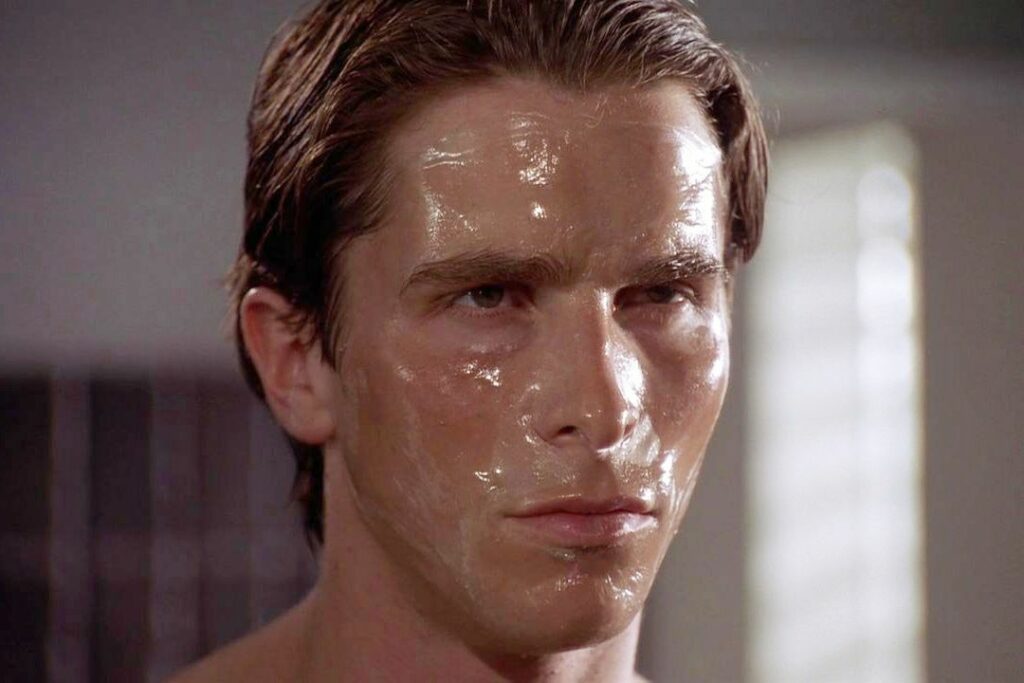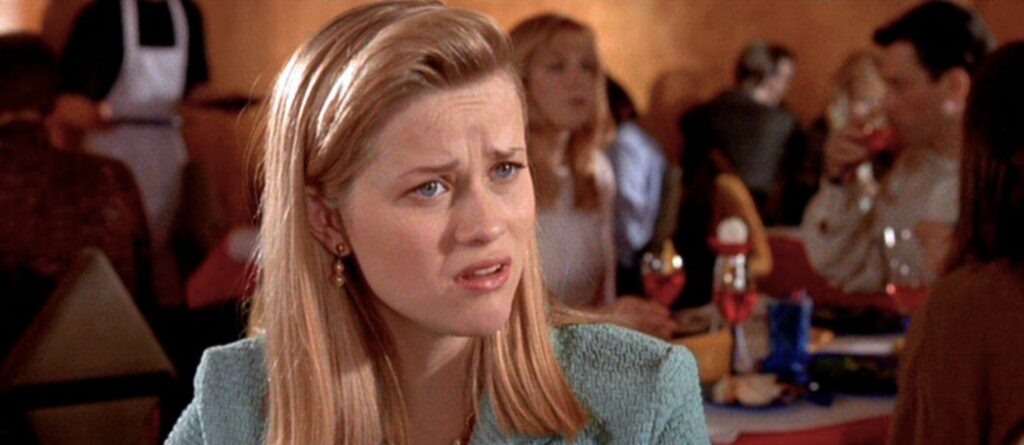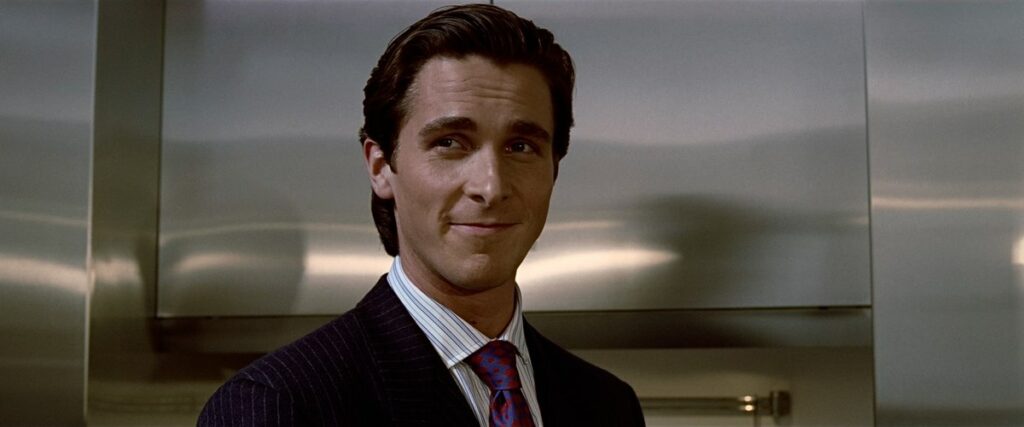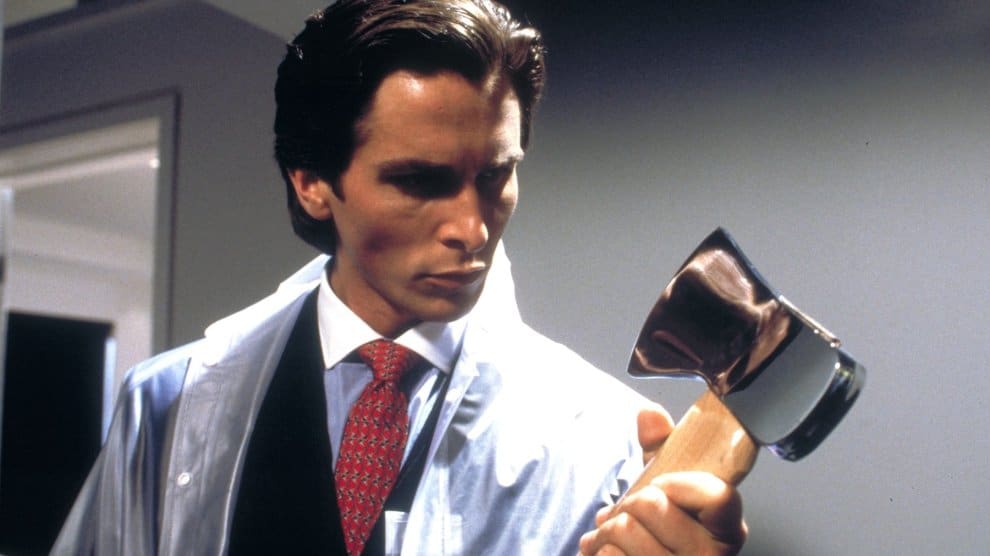Welcome to Original Characters, an ongoing series of Industrial Scripts’ articles examining the most original characters to appear in both TV and film. This article will focus on Patrick Bateman from American Psycho.
Table of Contents
What is an Original Character?
It’s a character that sticks with you even when they’re long gone from your screens. It’s a character that serves as a reference point in casual conversation. Or it’s a character that sums up a behavior or generation.
original, adjective
“Not the same as anything or anyone else and therefore special and interesting.”– from The Cambridge English Dictionary
Most importantly, in screenplay terms, an original character is a character that shines through in spite of any other weaknesses within that screenplay.
For a Screenplay Reader or Development Executive, an original character is an element of the script that stands out. No matter how busy they are or no matter how much work other elements of a script need, the original characters steal the show.
Great characters are at the very heart of great screenwriting and original characters can help to elevate great to superlative.
They may be plucked from real life or an amalgamation of real people. Or they might just simply be a genius stroke of creativity. Either way, these are original characters…
The twenty-first of our original characters series will look at Patrick Bateman from American Psycho.
*The following article contains spoilers for American Psycho*
Who is Patrick Bateman?

Who is Patrick Bateman? A question that Bateman himself doesn’t really know the answer to.
Bateman is a 27-year-old investment banker on Wall Street and the villain protagonist of American Psycho. By day, Bateman lives a lavish lifestyle consisting of dining at popular restaurants with his wealthy associates. But by night, he’s a raging serial killer.
In order to keep up his appearance, Bateman is engaged to socialite Evelyn Williams; although, both are having affairs. Between his job and social life, Bateman displays all the characteristics of the 80s, stereotypical Wall Street yuppie. He’s addicted to sex, drugs, and conspicuous consumption.
yuppie, noun
“a young person who lives in a city, earns a lot of money, and spends it doing fashionable things and buying expensive possessions.”
– from The Cambridge English Dictionary
Bateman slowly loses touch with reality as he kills more and more people. Being a narcissist, he feels inadequate when his masculinity is challenged around his wealthy associates. Killing people seems to be the only way for him to deal with this.
After killing a homeless man and an associate, Paul Allen, Bateman continues to give into his homicidal tendencies with sex workers and women he meets at clubs. He isolates himself further and further from his colleagues and from society at large.
Complex, Three-Dimensional Characters
Three-dimensional characters need to be complex and unique with traits that make them seem like real-life people. Even though Patrick Bateman is a vile character, he has different layers to him that make him believable and interesting to follow.
- He begins as a greedy and conceited investment banker.
- Quickly he becomes a serial killer.
- Finally, he turns himself in when he begins to feel lost.
There’s no particular reasoning or backstory about why Bateman does what he does, making it difficult to feel any sympathy for him. However, the amount of emotion that Christian Bale brings to the character humanizes Bateman, like the scene where he confesses to his lawyer about all the murders. Moreover, there’s cartoonish humor to the way he acts, an over-the-top tone that makes it easier to take his behavior with a pinch of salt.
A protagonist doesn’t need to be likeable in a traditional sense. There just needs to be something about them that’s striking and interesting. Bale’s performance provides us with some bizarre, hilarious, and terrifying moments that have made the character memorable and distinctive even years after the film’s release.
He’s a character that challenges the audience to engage with him and seems to throw out the rule book when it comes to creating a likeable protagonist. However, whilst we may not have empathy for him, there’s still a core of internal conflict within him that makes us stay engaged with his journey.
Patrick Bateman’s “Relationships”
Patrick is constantly surrounded by materialistic and conceited individuals. Therefore, none of Bateman’s relationships are very meaningful to him. However, they do enhance his story and show different sides of him.
Jean and Patrick Bateman
Jean is Patrick’s assistant. She’ll make reservations, do business tasks, and even change what she wears all at Patrick’s request. And she carries all this out whilst often looking glowingly at Patrick.
In Patrick’s life, Jean is the only person he comes close to caring about. She’s the only person that he seemingly doesn’t see as completely shallow. Jean’s also the only person who seems to care about Patrick. She’s curious about his life, unlike his self-involved friends or colleagues.
Moreover, Jean finds Patrick’s notebook full of drawings detailing the murders, meaning that she’s the only one who knows the true Patrick.
When Patrick invites Jean to dinner, she goes to his apartment beforehand. It seems that Patrick is going to kill her, but in the end, he lets her go. He tells her, “I think if you stay, something bad will happen. I think I might hurt you”. This proves that Jean means something different to Patrick than others do. In this way, she highlights the choices he makes when it comes to whom he chooses to kill.
More importantly though, in the glowing way Jean seems to revere Patrick, she satisfies his ego. She doesn’t undermine him and the power dynamic is very clearly in his favor. In this way, she’s seemingly uninteresting to him and not worth conflicting with, someone who ticks the boxes when it comes to what he’s looking for in human interaction.
Paul Allen and Patrick Bateman

Dorsia. The only restaurant Patrick where can’t get a reservation, but Paul Allen can.
Paul is also an investment banker. He has a lifestyle that Patrick demands to have. Patrick wants to be admired and praised, but Paul makes him feel lesser.
- First, Paul mistakes him for another investment banker.
- He has a better business card than Patrick.
- And, he calls Patrick Bateman a loser.
Patrick gets Paul very drunk, and at his apartment, kills him with an axe. Before Patrick invites Paul to his apartment, we already know the psychopath living in him, but are unsure of what to expect. This is the first of his on-screen kills. Blood spatters onto Patrick’s face and he looks relieved about what he just did.
This scene, besides showcasing the fact that Bateman knows a lot about music, creates a trope for the audience. Patrick likes to play music for his victims before killing them. Paul is our gateway for Patrick’s murderous exploits, the one who serves as a template.
Not only does Paul allow us to see the true extent of Patrick’s violence but he also demonstrates the feelings that drive Patrick; jealousy, resentment, ego. It’s a formula we’ll come to be increasingly familiar with as the film goes on.
Detective Kimball and Patrick Bateman
Detective Donald Kimball is in charge of investigating the disappearance of Paul Allen.
He’s a pretty unsettling character and makes Patrick nervous whenever around. This is partly because, for all of Willem Dafoe’s scenes as Detective Kimball, director Mary Harron had him act three different ways.
- He’s unaware that Patrick killed Paul.
- He’s suspicious of Patrick and wants to know more.
- He’s aware that Patrick killed Paul and is looking for a confession.
This further accentuates the air of mystery around Patrick’s actions and the ambiguous relationship he has with the truth and reality.
Patrick’s never caught for murdering Paul. But then again Patrick is told by his lawyer that he saw Paul only a few days ago. This makes you think, did Patrick actually kill all these people or was it all in his head?
No matter the opinion, Kimball never figures out that Patrick killed Paul, but makes him question himself. Kimball turns the screw on Patrick, something that is essential in escalating the stakes and highlighting the conflict, both external and within Patrick’s mind.
Evelyn Williams and Patrick Bateman

Evelyn is engaged to Patrick. While they keep up their relationship, mostly for looks, both of them frequently have affairs. Evelyn is as oblivious to others around her as everyone else. Most of the time when she’s talking, Patrick’s not even listening.
After Patrick kills Christie and Elizabeth, he realizes that there’s something wrong with him. He tries to tell Evelyn that he’s a murderer. However, like always she’s too self-absorbed to listen to what Patrick is saying, even though he’s drawn a picture of dead Christie on the tablecloth next to her.
Patrick breaks up with her, something that seems to genuinely, perhaps surprisingly, upset her. Uncomfortable with this public display of emotion, Patrick leaves urgently. This sends him on a killing spree through the streets of New York City.
Overall, Evelyn helps illustrate the facade that is Patrick’s life. Their relationship is superficial and is really just for the sake of keeping up appearances. Patrick breaking it off with her does mark a turning point in his character development. However, it’s not the relationship itself that causes Patrick to spiral but his gradual deconstruction of his seemingly perfect life and his embrace of his murderous, psychotic true self.
“My need to engage in homicidal behavior on a massive scale cannot be corrected but I have no other way to fulfil my needs”
– Patrick Bateman
Struggle for Power
Patrick continuously feels powerless or inadequate. This is most often the case when he’s around his male associates.
In his everyday work life, he’s surrounded by competitive, power-hungry males with inflated egos. Patrick has a fragile male ego himself, causing him, therefore, to feel challenged by everyone. Bateman’s associates and himself use their business cards as a way of showing off their masculinity, yet everyone’s the same as the next guy, with comically minor differences.
Not even Bateman realizes the norm of these Wall Street men he conforms to because his greed overpowers that. He even says, about himself…
“I have all the characteristics of a human being – flesh, blood, skin, hair – but not a single clear, identifiable emotion except for greed and disgust.”
– Patrick Bateman
Patrick struggles for power, yet, he’s competing against people who all have the same designer suits, business cards, and fancy dinner reservations. Everyone even has the same phone numbers on their business cards. Patrick talks about wanting to fit in, but that’s really just holding him back. He ultimately decides that he can’t truly stand out amidst this group and that to attain true power he must kill.
The scene in which Patrick and his associates compare their business cards is a brilliant satire on this world’s hyper-competitiveness. Patrick is smug and delighted by his fancy new business card but is shamed by the others’ cards, which are all basically the same albeit with purposefully fancy details to distinguish them. This is a petty world of one-upmanship, one which Patrick eventually decides that to compete within he must destroy.
Psychology of Patrick Bateman
Patrick Bateman is a textbook narcissist.
- He seeks attention
- Wants people to admire him
- Gets upset by the slightest bit of criticism, and
- Doesn’t understand or care about the feelings of others.
Bateman craves the attention and admiration of those around him by wearing expensive suits and having extensive, and slightly obnoxious, face and workout routines.
He’s also, most definitely, a psychopath.
He’s a very unstable and aggressive person. One small incident can set him off. For example, he kills Elizabeth when she makes fun of him for listening to Whitney Huston. And he kills countless others with seemingly little to no purpose. The only thing important to Patrick is his self-image. Not his job or advancing his career, only the kind of person others see him as.
It’s when this starts to unravel that he becomes increasingly psychotic. Patrick Bateman is a brilliant study and satire of a fragile masculine ego; a constructed personality that can ultimately be shattered with the slightest of comments. Whilst the study comes via the very recognizable portrayal of the kind of hyper-masculine world that Patrick is a part of, the satire comes in the extreme lengths Patrick goes to in order to keep up with this world and satisfy his monstrous, out-of-control ego.

Reality vs. Constructed Reality
Did Patrick kill all those people, or was it all in his head? The twist at the end of the movie leaves you wondering.
Patrick Bateman, the narrator of his own story, sets up what we are to believe is reality. With Bateman’s extensive facial routine, it seems he’s a stuck-up and arrogant person with a homicidal inner voice. However, by seeing the world around him along with his narration, it becomes clear that he’s something of an unreliable narrator.
An unreliable narrator is a first-person narrator of a story that can’t be trusted for a complete or truthful account of that story.
First, we see that he may not be all together when he goes to a club and threatens the bartender. It sounds as if Patrick is telling the woman that he wants to kill her, but when she turns back around, she seems oblivious to it.
Furthermore, near the end of the movie, Patrick is at an ATM when a stray cat passes by. He picks the cat up and the ATM reads: “Feed me a stray cat”. The next couple minutes of chaos includes the cops suddenly chasing after him, Bateman having incredible aim with a gun, and the fact that no one’s around while he runs from building to building killing security guards.
A few days later, after Bateman tells his lawyer he killed Paul Allen, he runs into him. Bateman tries to tell his lawyer, Harold, once again what he did, but Harold thinks it was all a joke and tells Bateman that he had lunch with Paul a few days ago.
Was It All In His Head?
Based on the unreliability of Patrick’s narration, it’s unclear whether or not he actually committed the murders. Throughout the movie, he’s disconnected from reality causing:
- Skewed priorities
- Evident disorders and psychosis
- Blurred identities
While Patrick believes he killed Paul Allen, it’s possible that he killed someone who he mistook for Paul. Everybody dresses and looks the same, so much so, that even Paul thought that Bateman was someone else. With this in mind, there’s a possibility that Patrick did the same thing.
Bateman knows what he’s doing is wrong, so he constantly talks about the murders to his co-workers and friends. But, since they’re all so self-absorbed, they don’t even notice. This is why, even if he did commit all the murders…
“This confession has meant nothing.”
– Patrick Bateman
Patrick being an unreliable narrator is just another reason why he’s such a compelling and original character. Nothing can be trusted in this world, not even the character that leads us through it. Nothing can be taken at face value.
Whilst we watch the actions Patrick commits with horror, his unreliability as a narrator makes us question the source of these potential fantasies. This, in turn, highlights the representation they are of his ego and psychosis. This isn’t a simple portrayal of a serial killer, it’s something much deeper.
In Conclusion: What Makes Patrick Bateman an Original Character?
Patrick Bateman is a character that says something striking and original about the world of Wall Street finance and the kind of toxic masculinity that’s often at its heart.
By taking things to the extreme, writer Bret Easton-Ellis and director Mary Harron provide a darkly comic satire on an egocentric world. Patrick’s actions may be extreme but their source is recognizable, stemming from a well of toxicity nestled amidst a society that seems to reward it.
Because of this controversial and acerbic take, Bateman remains a strong pop culture reference, years after the film’s release. He’s not your typical protagonist, what with him being a brutal serial killer and all. However, Christian Bale brings a strange chemistry to the character, primarily via the over-the-top satirical comedy intrinsic to his portrayal.
He’s a character that illustrates what a writer can achieve with an unlikeable protagonist. Every step of the way his actions, dialogue and behavior seem cartoonish. The film challenges us to laugh at the bizarreness of his behavior, even if the facts of it are deeply disturbing.
But it’s the way that his characterisation is so tightly tied to the film’s tone and intention does he become such a powerful and memorable character. Patrick Bateman may be somewhat of a caricature but in a film that seeks to highlight the absurdity of the world it picks as its target, he’s the perfect vessel.
– What did you think of this article? Share It, Like It, give it a rating, and let us know your thoughts in the comments box further down…
– Struggling with a script or book? Story analysis is what we do, all day, every day… check out our range of script coverage services for writers & filmmakers.
This article was written by Allison Havrilla and edited by IS Staff.
Get *ALL* our FREE Resources
Tackle the trickiest areas of screenwriting with our exclusive eBooks. Get all our FREE resources when you join 60,000 filmmakers on our mailing list!

